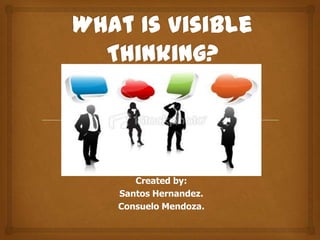Report
Share

Recommended
Recommended
More Related Content
What's hot
What's hot (20)
Class session 2 theoretical orientations a framework for the course

Class session 2 theoretical orientations a framework for the course
PowerPoint Presentation 1: Overview of Learning Theories

PowerPoint Presentation 1: Overview of Learning Theories
Class 6 intro to mezirow's transformative learning theory

Class 6 intro to mezirow's transformative learning theory
Class 7, learning from experience, reflection and co ps

Class 7, learning from experience, reflection and co ps
Making meaning: Knowledge creation, learning and documentation

Making meaning: Knowledge creation, learning and documentation
Viewers also liked
Viewers also liked (19)
Similar to Visible thinking 1
Similar to Visible thinking 1 (20)
Planning for Effective Learning Experiences - Dr Christine Redman

Planning for Effective Learning Experiences - Dr Christine Redman
Inquiry cycle- A tool for co-construction of contexual and conceptual underst...

Inquiry cycle- A tool for co-construction of contexual and conceptual underst...
Practicum in language lane 462.- a brief summary , dr. shadia y. banjar.docx

Practicum in language lane 462.- a brief summary , dr. shadia y. banjar.docx
Rethinking Education in the Digital Age Ferrarelli m

Rethinking Education in the Digital Age Ferrarelli m
Critical Thinking Routines for the Modern Classroom

Critical Thinking Routines for the Modern Classroom
Universal Design for Learning: Differentiated Instruction

Universal Design for Learning: Differentiated Instruction
Recently uploaded
God is a creative God Gen 1:1. All that He created was “good”, could also be translated “beautiful”. God created man in His own image Gen 1:27. Maths helps us discover the beauty that God has created in His world and, in turn, create beautiful designs to serve and enrich the lives of others.
Explore beautiful and ugly buildings. Mathematics helps us create beautiful d...

Explore beautiful and ugly buildings. Mathematics helps us create beautiful d...christianmathematics
Mehran University Newsletter is a Quarterly Publication from Public Relations OfficeMehran University Newsletter Vol-X, Issue-I, 2024

Mehran University Newsletter Vol-X, Issue-I, 2024Mehran University of Engineering & Technology, Jamshoro
Recently uploaded (20)
Explore beautiful and ugly buildings. Mathematics helps us create beautiful d...

Explore beautiful and ugly buildings. Mathematics helps us create beautiful d...
ICT Role in 21st Century Education & its Challenges.pptx

ICT Role in 21st Century Education & its Challenges.pptx
Basic Civil Engineering first year Notes- Chapter 4 Building.pptx

Basic Civil Engineering first year Notes- Chapter 4 Building.pptx
Z Score,T Score, Percential Rank and Box Plot Graph

Z Score,T Score, Percential Rank and Box Plot Graph
Unit-IV; Professional Sales Representative (PSR).pptx

Unit-IV; Professional Sales Representative (PSR).pptx
Measures of Central Tendency: Mean, Median and Mode

Measures of Central Tendency: Mean, Median and Mode
Web & Social Media Analytics Previous Year Question Paper.pdf

Web & Social Media Analytics Previous Year Question Paper.pdf
ICT role in 21st century education and it's challenges.

ICT role in 21st century education and it's challenges.
Role Of Transgenic Animal In Target Validation-1.pptx

Role Of Transgenic Animal In Target Validation-1.pptx
Food Chain and Food Web (Ecosystem) EVS, B. Pharmacy 1st Year, Sem-II

Food Chain and Food Web (Ecosystem) EVS, B. Pharmacy 1st Year, Sem-II
Asian American Pacific Islander Month DDSD 2024.pptx

Asian American Pacific Islander Month DDSD 2024.pptx
Visible thinking 1
- 1. Created by: Santos Hernandez. Consuelo Mendoza.
- 2. LEARNING IS A CONSEQUENCE OF THINKING
- 3. What is Visible Thinking? Visible Thinking is a research-based approach to teaching thinking, begun at Harvard's Project Zero, that develops students' thinking dispositions, while at the same time deepening their understanding of the topics they study.? Rather than a set of fixed lessons, Visible Thinking is a varied collection of practices, including thinking routines small sets of questions or a short sequence of steps as well as the documentation of student thinking. Using this process thinking becomes visible as the students‘ different viewpoints are expressed, documented, discussed and reflected upon. Using thinking routines and documentation to deepen students' understanding.
- 4. Six Key Principles of Visible Thinking
- 5. 1 Learning is a Consequence of Thinking Share and Build Knowledge 2 Only a Matter of Good Thinking is Not Skills But Also a Matter of Dispositions Curiosity and Openmindness 3 The Development of Thinking is a Social Endeavor Conversations, Engagement, and Cooperative Learning
- 6. 4 Fostering Thinking Requires Making Thinking Visible Speaking, Writing, Drawing, and Graphic Organizers for Later Reflection 5 Classroom Culture Sets the Tone for Learning and Shapes What is Learned -classroom routines/structure -language/discussions -explicit/implicit expectations -time allocation -modeling -physical environment -relationships/interactions -opportunities 6 Schools Must be Cultures of Thinking for Teachers "Professional Learning Communities"
- 7. A Strategy to Make Thinking Visible is Think-Puzzle-Explore
- 8. Think about a topic Identify Puzzling Questions Explore Puzzling Questions
- 9. Explore Puzzling Questions “A pad of hairs called a scopula may surround the claws. The scopula sticks to smooth surfaces and helps the spider walk on ceilings and walls.”
- 10. Think-Puzzle-Explore is Similar to the KWL chart but there are Important Differences -Both tap into prior knowledge but Think- Puzzle-Explore asks "what they think they know" rather than "what they know." -Open ended approach enables students to offer thoughts rather than definite knowledge. -Encourages the reluctant student to participate in discussions, since all thoughts are accepted.
- 11. Implications for Teaching Learning Process Classroom activities become more learning centered rather than work orientated. Builds confidence of all students by increased participation and motivation. Promotes risk-free environment in order to lose the feeling to fail. Assesses student thinking by using visible documentation and presentations.